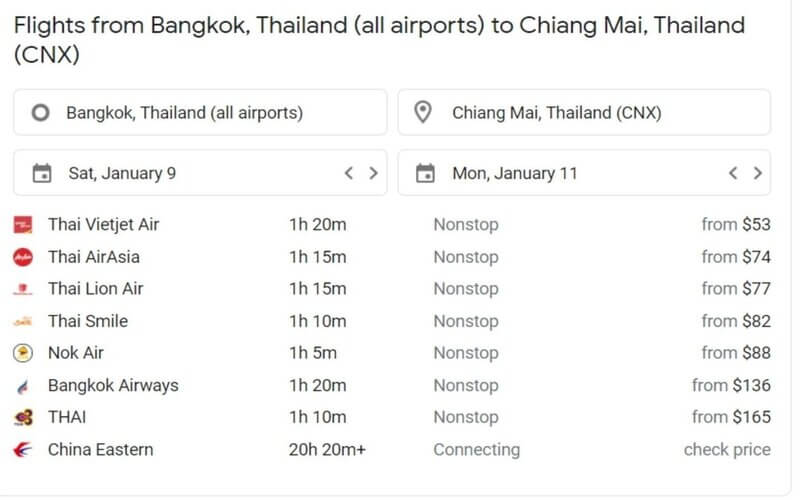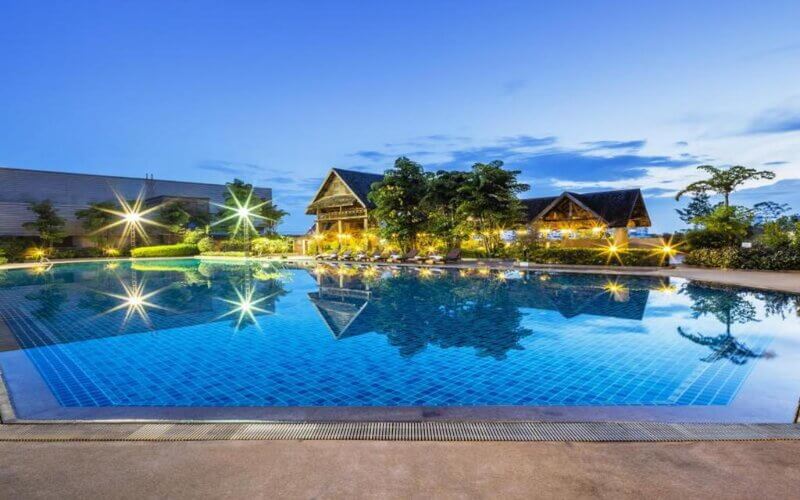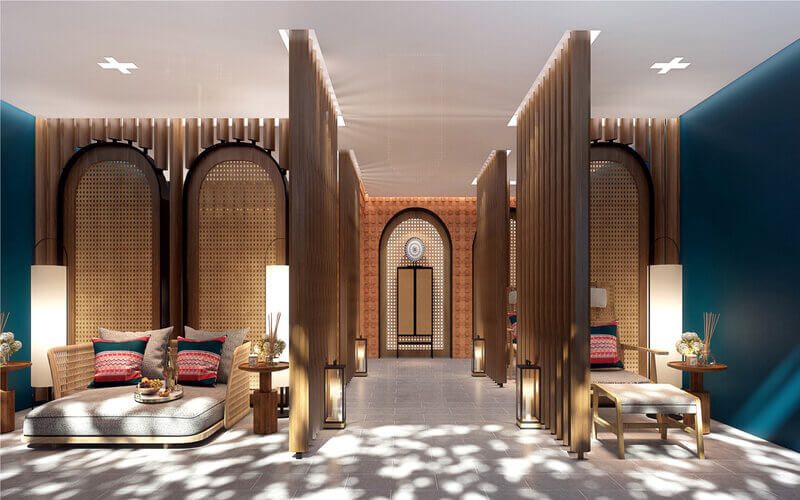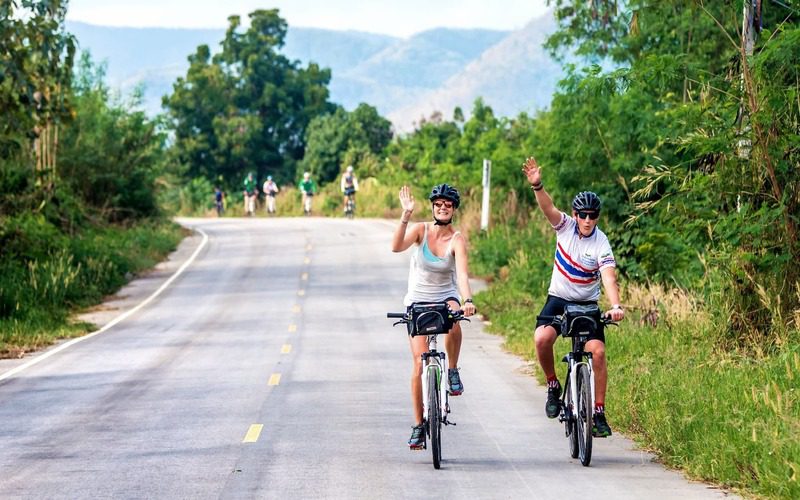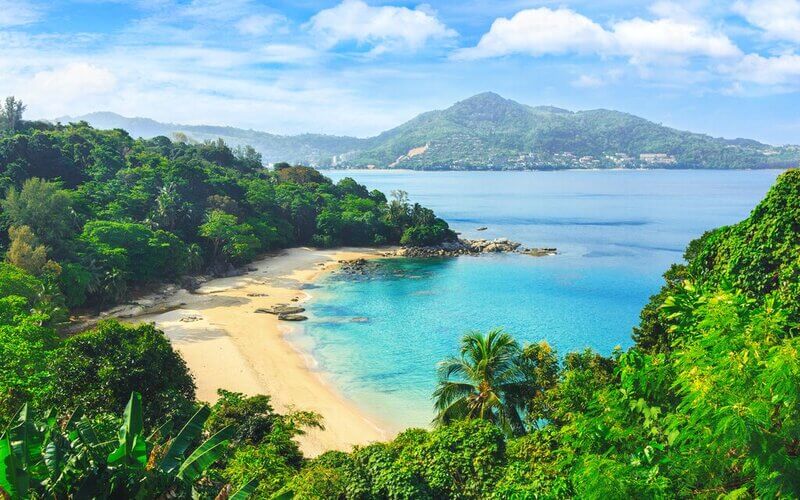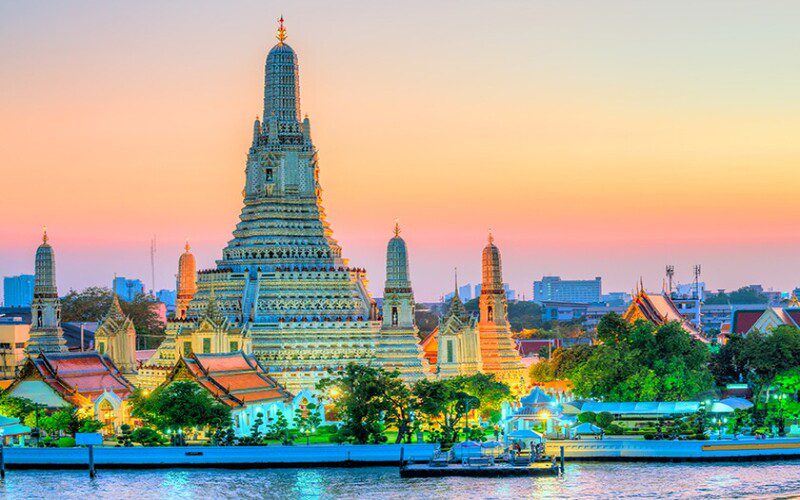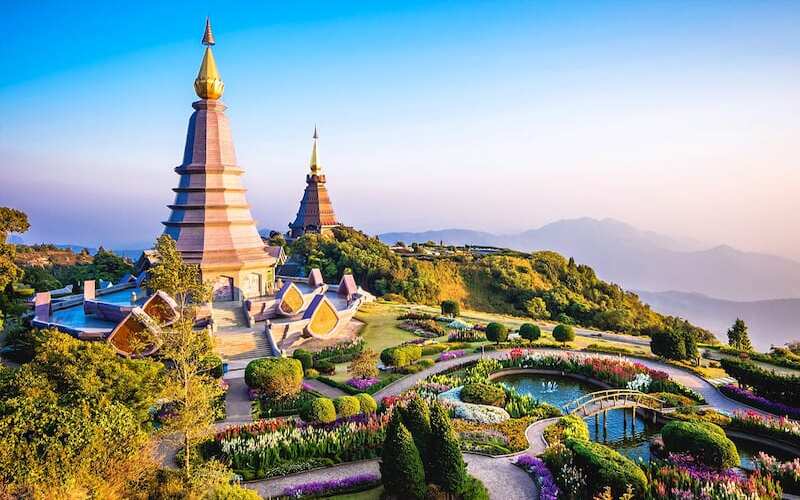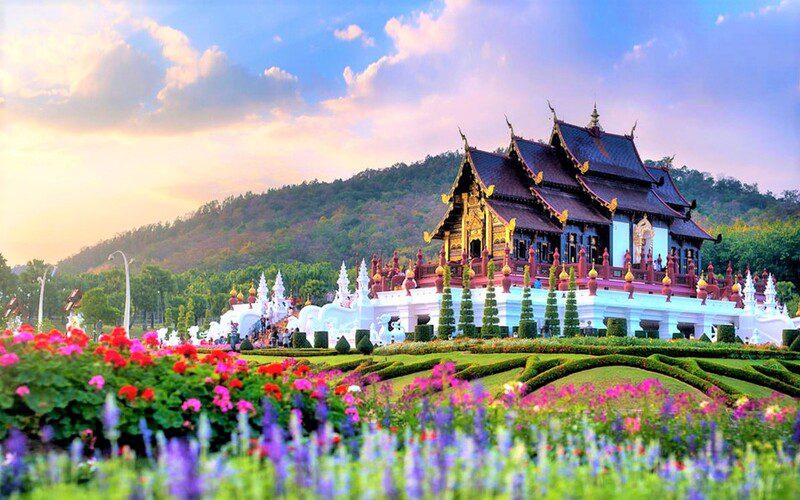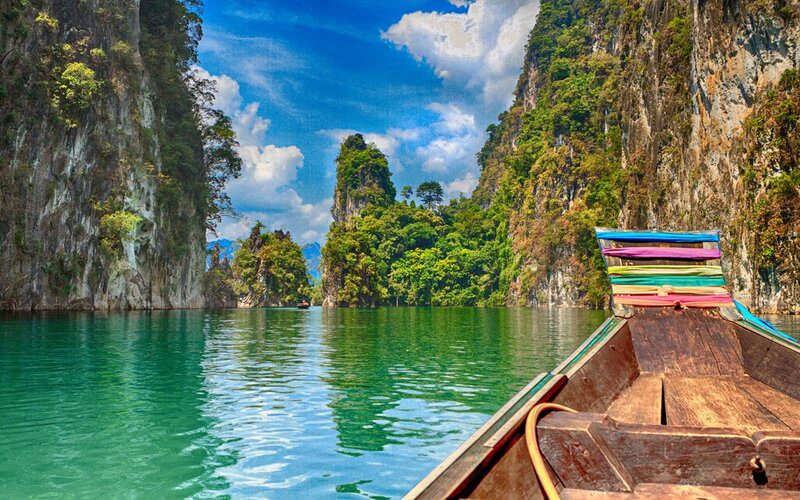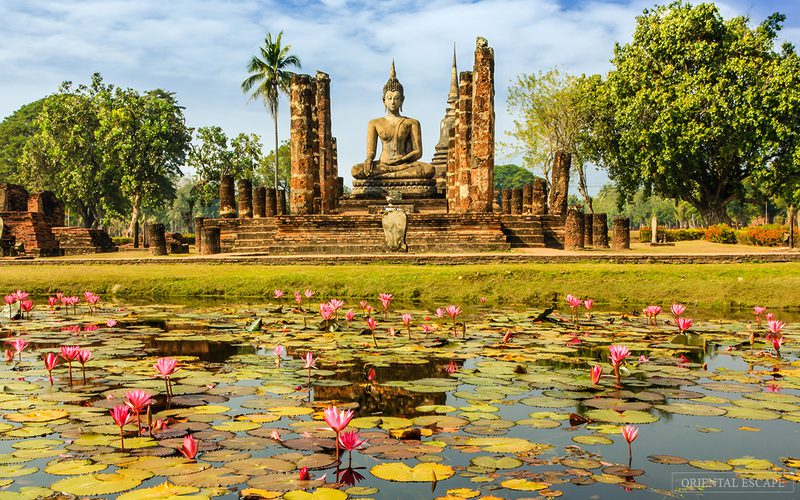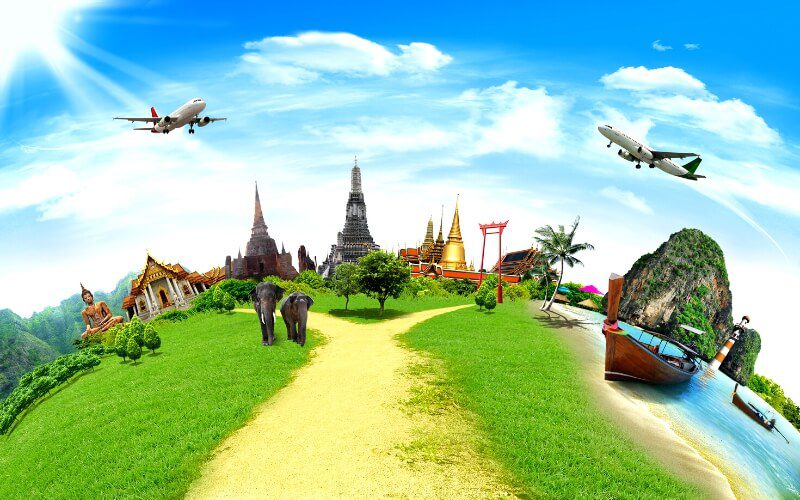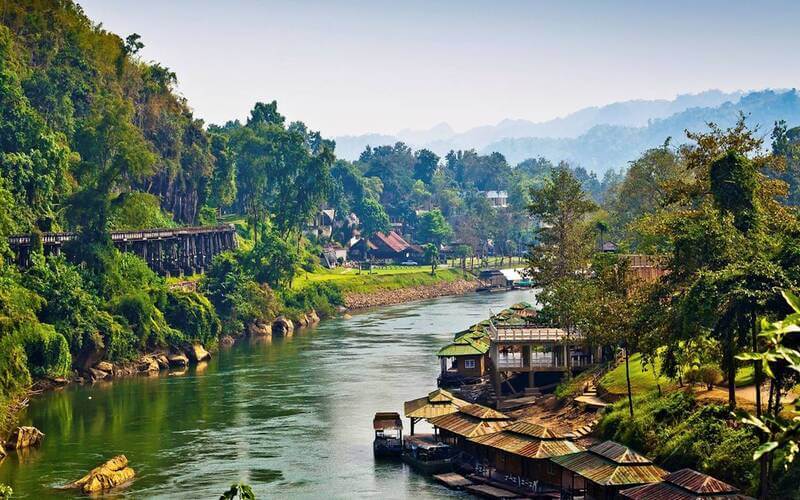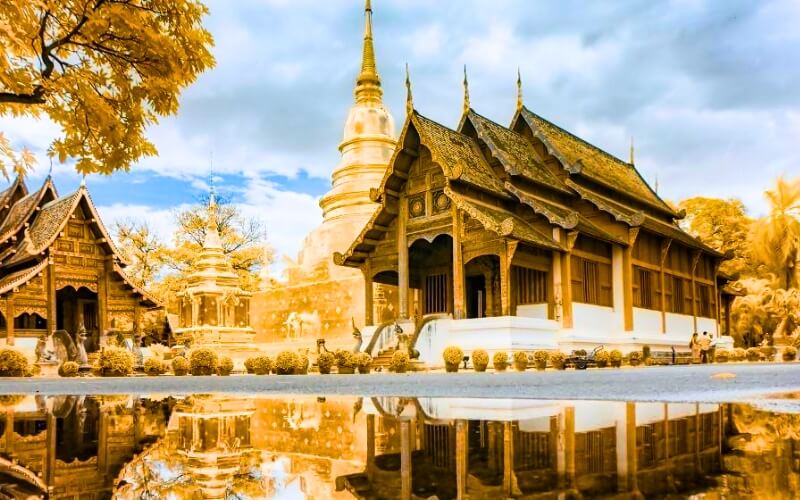Chiang Mai is the second-biggest city in Thailand, just after Bangkok. It is located 700 km to the North of Bangkok, in a mountainous area, near the border with Laos and Myanmar. The infamous “Golden Triangle”, where these three nations meet, is not far from here.
General Information
Chiang Mai means “new city” in Thai. It was the capital of the thriving 700-year-old Lanna Kingdom in the North of Thailand. It’s also an ancient city with the perfect blend of mountains, historic architecture, and many activities waiting for you to explore.

Top Attractions in Chiang Mai
Weather in Chiang Mai and the Best Time to Visit
Located in the mountainous region of Northern Thailand, Chiang Mai has a very seasonal climate, with temperatures that can reach 40°C in summer and drop below 10°C in winter. Compared to Bangkok and other cities in southern Thailand, Chiang Mai is slightly cooler and enjoys relatively lower humidity. This city has three main seasons:
- Cool season (November – February): This is the most comfortable time of the year, with daytime temperatures around 28°C, and night temperatures can drop to 10°C. If you go to the mountains, like Doi Inthanon National Park where the temperature can drop to 3°C. These months also have the lowest rainfall, so the humidity is low and the sky is blue and cloudless. With little rain, outdoor activities will not be threatened by bad weather either. This is the ideal time to visit Chiang Mai as the weather is perfect for all sorts of activities.
- Hot Season (March – May): The hot season, which starts from March to May, is the hottest time of year in Chiang Mai, with midday temperatures often exceeding 32°C. On average, April is the hottest month with daytime temperatures reaching 40°C. This period is when Chiang Mai suffers from air pollution due to forest fires and farmers burning their farmland to prepare the soil for more fertility for the next harvest.
- Rainy season (June – October): The temperature during the rainy season cools down although the air humidity is high (30-65%). This wet weather is caused by the Southwest monsoon, which arrives from India at the end of May. With monsoon rains, the sky becomes clearer as all the smoke and dust are washed and blown away.
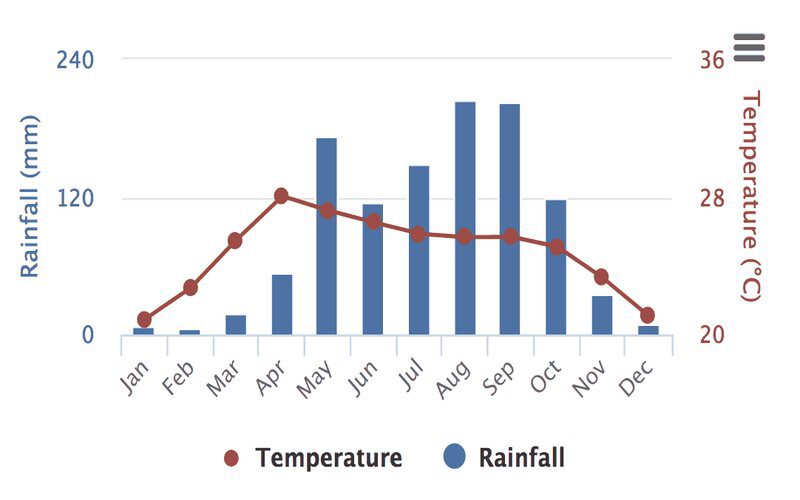
Weather in Chiang Mai
The cool season is Chiang Mai’s peak tourist season. Thanks to the pleasant weather conditions, it is also the high tourist season which sees a very large influx of local and foreign tourists. As a result, the cost of accommodation is higher at this time of year, and restaurants and places of interest are busier. So, you should book all services in advance if you plan to visit Chiang Mai at this time of year.
Getting to Chiang Mai
Plane
Chiang Mai International Airport is 6 km away to the North West of the city, welcoming more than 2 million guests per year (before Covid). It has a terminal for domestic flights and another for international flights.
- Domestic flights are mainly from Bangkok, Krabi, etc.

Planes from Bangkok to Chiang Mai with ticket price
- International flights are from Singapore, Taiwan, Laos (Luang Prabang), Myanmar (Mandalay, Yangon), and Vietnam (Ha Noi, Ho Chi Minh City).
Train
Chiang Mai Railway Station is the terminus of the Northern line from Bangkok, it is the best maintained of the network. By this line you can take advantage of the newly renovated wagons, they are specifically made to adapt to the new requirements of travelers (electrical sockets, more comfortable seats, beds, and cabins).
Taking the night train is also a good idea, you can save more time, and it also gives you a moment from the trip. We depart from Bangkok in the early evening and arrive at Chiang Mai early in the morning. It can be quite enjoyable and ecological at the same time.
Three classes offered many choices for tourists, from the reclining seats to the cabin, the options are versatile and generally very accessible.
Bus
The bus may be the most economical means of transport. The services are good, the night VIP buses are very comfortable, and the seats are wide and reclinable. It can be an option for those who want to save time and money.
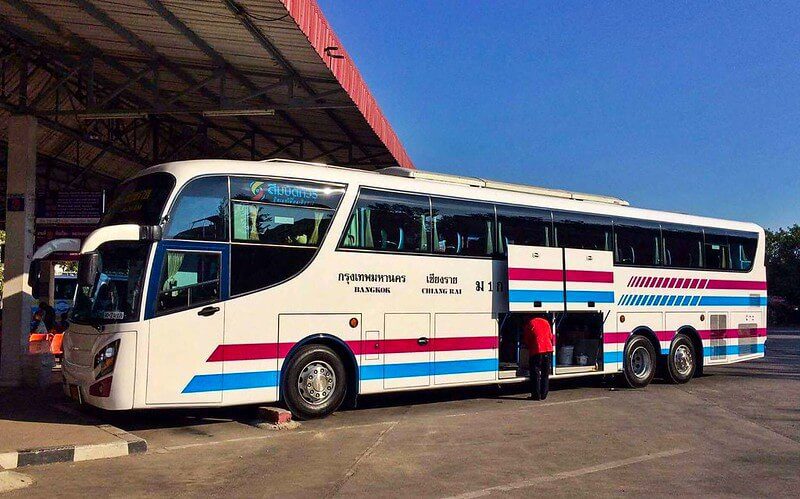
Overnight bus from Bangkok to Chiang Mai
Private car
Renting a private car is very necessary if you want to travel freely. IDC Travel offers you a car rental service with a driver so you can enjoy the most out of your trip to Chiang Mai, and its surroundings. Please contact us for more information.
Getting around Chiang Mai
Songthaew
The songthaew is the most common and preferred mode of local transport in Chiang Mai. You will find them easily on the street of Chiang Mai, day or night. Just wave at one on the road or approach a waiting driver and tell them where you want to go. If it’s on the classic route or the driver is going in that direction, you just need to ask for the price and then get on.
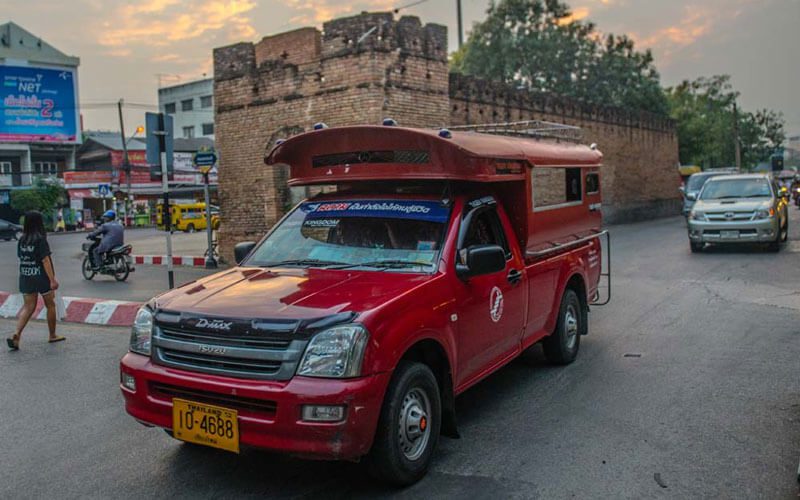
Songthaew in Chiang Rai
Tuk-tuk
Thai tuk-tuk is very popular, they are fast and loud and would go everywhere, depending on your negotiation skill, it can be very cheap.
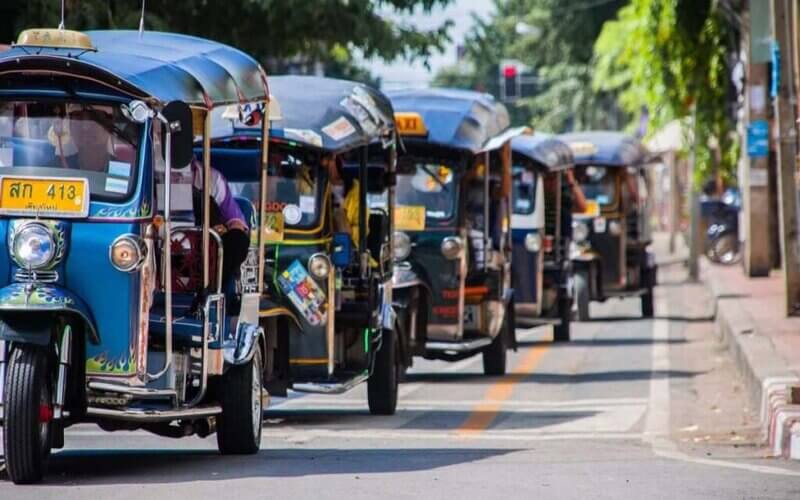
Tuk-tuk
The tuk-tuk, after Songthaew is the second most common mode of transport in Chiang Mai. Compare to Songthaew, tuk-tuk is more expensive, the fare starts at 60 bahts for a short trip and 100-150 bahts for a longer distance.
Samlor
The samlor, which means “three wheels” in Thai, is mainly used by tourists who walk around the old town or by some inveterate vendors who use it to transport their goods to the markets. They can be found around the Waroto Market, near the river.
Bus
Since 2018, the blue buses run by RTC Bus are an affordable and comfortable way to travel around Chiang Mai’s central area. These spacious air-conditioned buses carry passengers along nine routes and can be tracked in real-time via CM Transit mobile app. The fare is 20 bahts each way, you can pay in cash or with the Rabbit stored value card (you can get it from the RTC stand at the airport and top it up as needed at local shops).
Taxi/Grab
Air-conditioned taxis are available in Chiang Mai, but they are very few and hard to find. These taxis don’t run around the city, they wait at the airports, train stations, bus stations, malls, and hotels.
The Grab carpooling mobile app may be the most convenient way (for public transport) to get around Chiang Mai. The fare can be cheaper than a taxi if you use the latest promotion code (which is frequently available).
Moto – taxi
Motorcycle taxis are available at Chang Phueak Bus Station and Arcade Bus Station. Unlike Songthaew and tuk-tuks, these motorbike taxis would not move around to search for passengers, they gather in groups at the bus stations.
Look for their pink vests, tell them where you want to go and get on. The fare normally starts from 50 bahts (and it is always negotiable) and it’s cheaper than a taxi or tuk-tuk.
Segway
You can get on a Segway and ride along the small lane between the ancient temples and coffee shops, it is a new and fun way to travel around the city.
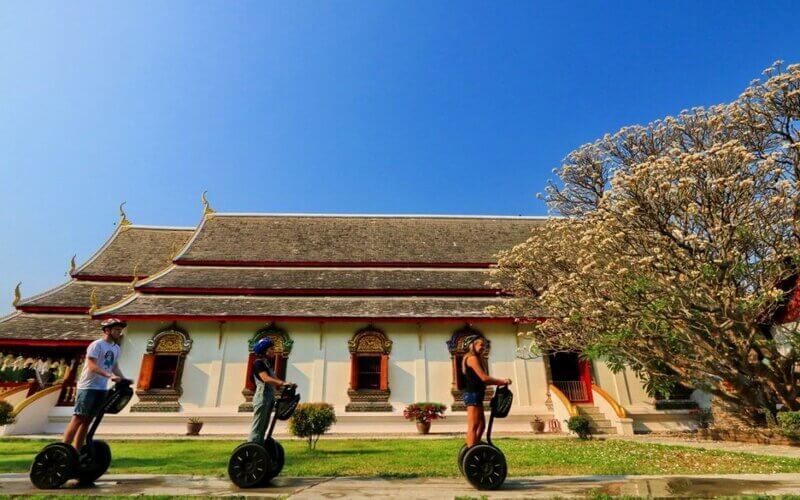
Explore Chiang Mai by Segway
Where to Stay in Chiang Mai
You won’t find any problems in finding hotels in Chiang Mai. Hostels, guest houses, luxury hotels, etc. are for everyone and in every budget! The Old Town area is the most convenient and cheapest to stay. The Wat Ket district, located in the West of Chiang Mai, is where many luxury hotels are. If you come between November and February, the high season in Thailand, it is best to book in advance. Here are some of the best hotels for you to consider:
- Hotel:
- Lotus Pang Suan Kaew Hotel 4*
- Furama Chiang Mai 4*

Lotus Pang Suan Kaew Hotel – Chiang Mai, Thailand
- Deluxe:
- Melia Chiang Mai 5*
- Maladee Rendezvous Hotel 5*

Melia Chiang Mai
Best Places to Visit in Chiang Mai
Chiang Mai Old Town
The Old Town is where you should go if you want to explore the majority of Chiang Mai. It includes a big part of the main temple, you can also find markets, museums, numerous bars, and restaurants.
Bordered by a moat and surrounding walls, you can go through the Old Town through 4 main gates at the 4 cardinal points. You can relax and walk around to admire the traditional buildings.
Chiang Mai Temples
The temples are essential when visiting Chiang Mai, you can easily find them in the Old Town, some are free and some require payment to go in, but they are very cheap.

Wat Phra Singh
- Wat Phra Singh: One of the most famous and reserved temples by Thais in the city, thousands of people visit it every year and it’s free.
- Wat Chedi Luang: “Luang” means “big” in the Northern dialect, and as the name suggested, this temple is the home of the biggest Buddhist chedi in Chiang Mai, it is 98 meters high and 54 meters in diameter. The chedi was completed in 1481, during King Mengrai’s reign. The current Chedi Luang is a restoration, the old Chedi was destroyed by an earthquake in 1545.
- Wat Inthakhin Sadue Mang: It means “city navel temple”. It was named after the city pillar called Sao Inthakin, which was located near the temple. The viharn decorated with woodwork and gold structures houses the Buddha image known as Luong Pho Khao. The Inthakin Museum next to it exhibits relics from the Lanna Kingdom era.
- Wat Chiang Man: The oldest temple, it was erected by the founder of the city in the 13th century. There are 2 Buddha statues in this temple, one was made of marble, and the other is crystal.
- Wat Mahawan: It’s an attractive temple with Lanna and Burmese-style buildings and many mythical creatures.
- Wat Sri Suphan: Also known as “the silver temple” because it was built with this metal.
>>> Read more: Top 15 Must-Visit Temples in Chiang Mai, Thailand.
Doi Suthep National Park
The most popular place in the Park is Wat Phra That Doi Suthep. Located on top of a hill, it will give you a full view of Chiang Mai and its surroundings.
To reach this temple, you have to climb around 300 steps and then take an elevator (surcharge). But climbing the stairs is not really insurmountable, except that it is very hot. But that is normal when you travel to Thailand.
The entrance to the temple is 30 baht.
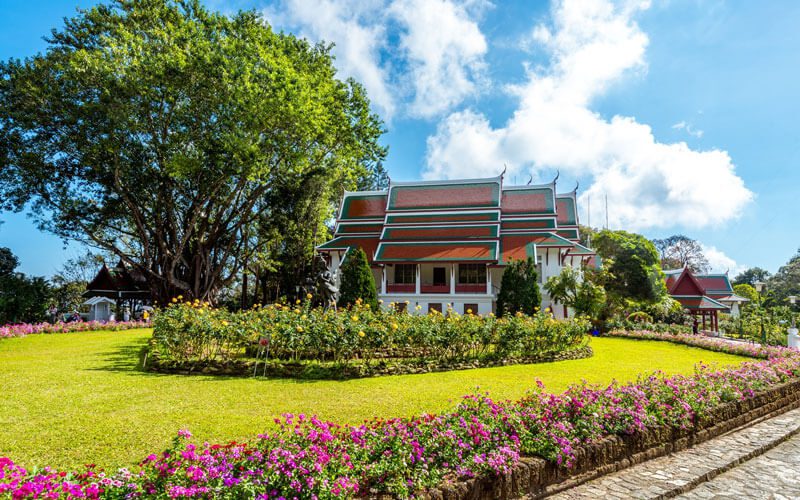
Bhubing Palace
Here are some attractions at the park:
- Bhubing Palace: This is the winter residence of the Thai royal family when they stay in the North. Only the garden is open for visitors, it is well maintained with many flowers. You must visit the rose gardens and the giant bamboo. Pay attention to your timetable because the palace generally closed at 3:30 pm, and you must wear pants (without holes and not tight) to be allowed to come in. The dress code is taken very seriously here.
- Doi Pui Hmong Tribe Village: The village is situated at the top of Doi Suthep. It’s the home of the Hmong tribe, one of the six main tribes in Thailand. This large village consists of a museum, a beautiful garden, houses, and a souvenir shop. It is worth coming for a visit.
- Mon Tha Than Waterfall
- Huay Kaew Waterfall
Huay Tung Tao Lake
It only takes 30 mins to travel to the North of Chiang Mai to visit Huay Tung Tao Lake. It is an ideal location to walk and rest. There are many bamboo huts where you can enjoy lunch or have a drink around the lake.
Chiang Mai Markets
- Talat Warorot Market: The biggest market in the city. You can find everything from food stalls to clothes here. It is located to the East of the Old Town and next to Chinatown.
- Night Bazza Market: Open daily from 6 pm, the market is on Chang Klan Road. Here you can find the handicrafts of the mountain ethnic groups, but the tourist market obliged, the price here is higher than elsewhere. You can treat yourself to one of the street food stalls.
- Sunday Market: It is a must to experience when you visit Chiang Mai, taking place every Sunday from 4 pm.
Museums in Chiang Mai
- Chiang Mai National Museum: Over 700 years old, this museum is dedicated to the city’s history, nature, and culture.
- Lanna Folk Art Museum: This museum aims to revive Lanna culture, provide young people with a better understanding of the special history of the North, and provide the city with a new tourist attraction.
- Art in Paradise Museum: One of the most visited sites in Chiang Mai, this is where you can take pictures of the 3D trompe l’oeil decor.
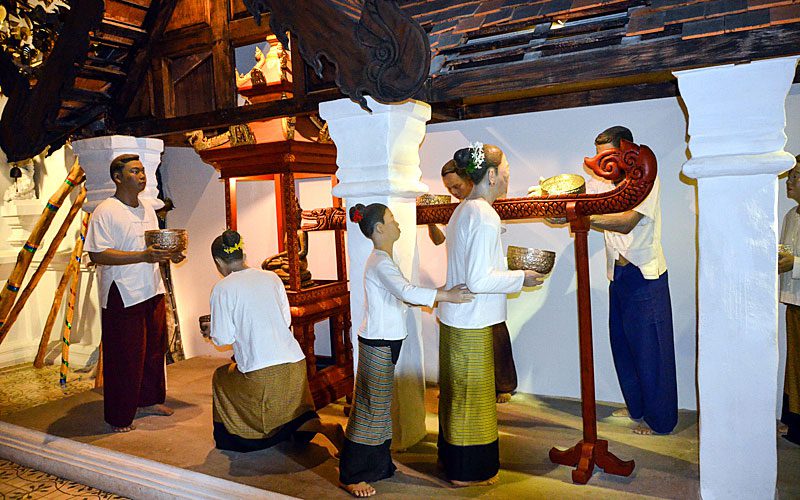
Lanna Folk Art Museum
Chiang Mai Zoo
The zoo has more than 7000 animals, including the famous panda couple offered by Chinese diplomacy to Thailand. The zoo was founded in 1952 by a missionary from the United States and covers 85 ha.
This zoo has more than 800 birds, a panda named “Lin Hui” (China donated), another panda “Chuang Chuang” who died in 2019, a Humboldt penguin, a free-living gibbon, more than 60 kinds of animals. Aquatic animals include fish – Mekong giant cats, giant Siamese carp, and the Ture eel.
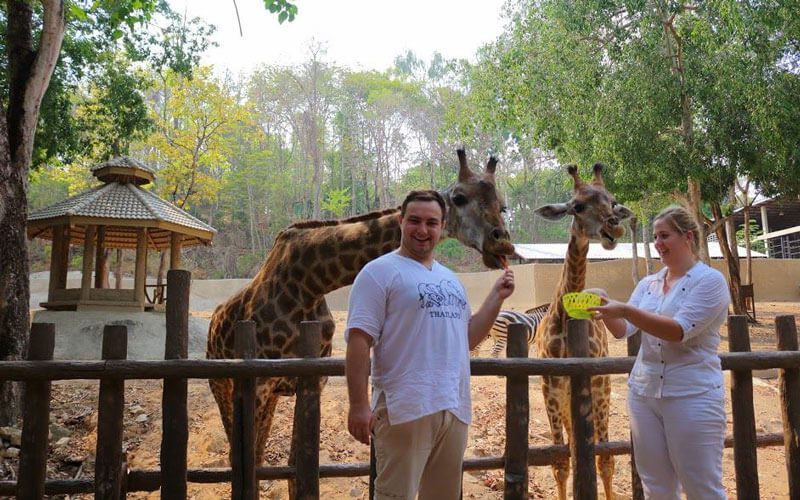
Visit the Chiang Mai Zoo
Must-Try Activities in Chiang Mai
Go to see the elephants
Elephants that have been abused and abandoned are welcomed and protected. You can help the staffs feed them and give them a bath by the river, and even ride on their back. Most elephants now respect a certain ethnicity and try to recreate a natural environment as much as possible.
One of the most popular destinations is the Elephant Natural Park, one of the first parks created aiming to preserve elephants.
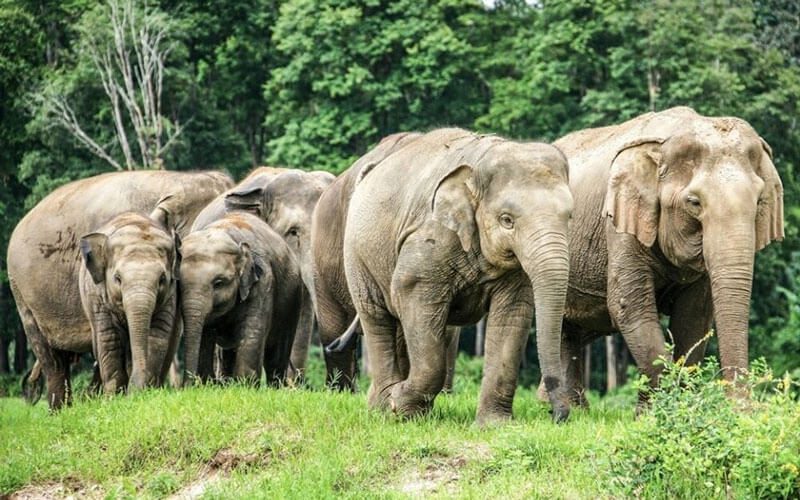
The Elephants Natural Park
Go trekking
Chiang Mai is a famous destination for natural trekking. You can choose one or more days for trekking and exploring the jungle of Northern Thailand. The best place to hike around Chiang Mai is Chiang Dao, Mae Tang, Mae Wang, or Doi Inthalon.
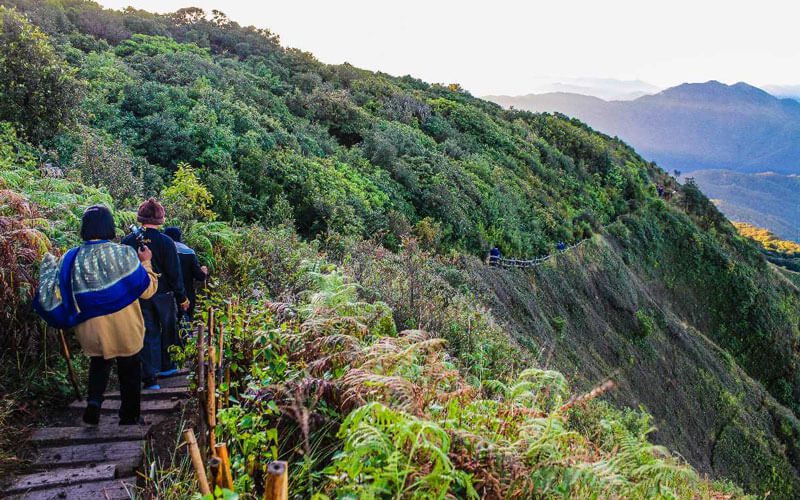
Chiang Mai trekking
Join a Thai Cooking Class
Chiang Mai owns mouth-watering cuisines and many travelers have taken the time to learn how to cook them. Some schools offer to teach you how to make delicious Pad Thai, curries, and especially Khao Soy, a specialty of the North – a curry soup with fried noodles and chicken.
Normally the class would take half a day, you will go to the market and prepare the ingredients, discover spices and aromatic herbs, then return to school to cook, and finally taste your own creations.
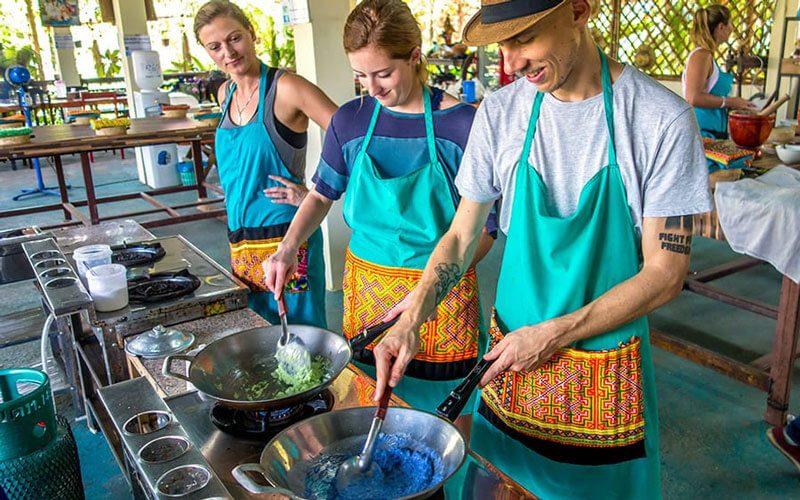
Cooking Class in Chiang Mai
Watch a Thai boxing match – Muay Thai
Thai boxing is impressive to watch! This combat technique originally comes from the Thai military training method and now becomes a national sport. Even if you do not enjoy violent sports, attending a match is still a worthy experience, the atmosphere in the crowd, the musicians, and the demonstration of simulated fights during warm-up surely won’t let you leave with disappointment.
There are 3 places where you can watch Muay Thai Chiang Mai, including Kalare Stadium, Thapae Boxing Stadium, and Loi Kroh Stadium.
Enjoy a Traditional Thai Massage
After a long day exploring Chiang Mai, there is nothing better than a traditional massage to relax. You can find massage parlors all around the city, near the temples, or around the Old Town. The hotels also offer some massage sessions and some hotels have very nice spas.
Must-try Delicacies in Chiang Mai
Khao Soy (Curries Chicken Coup)
Khao Soy is a rich and savory yellow noodle soup served with spring onions, pickled cabbage, and a slice of lime. Egg noodles are flat in shape, with a small handful of fried noodles mashed on top giving the broth more texture and tastier too. You can choose a chicken, pork, or beef khao soy.
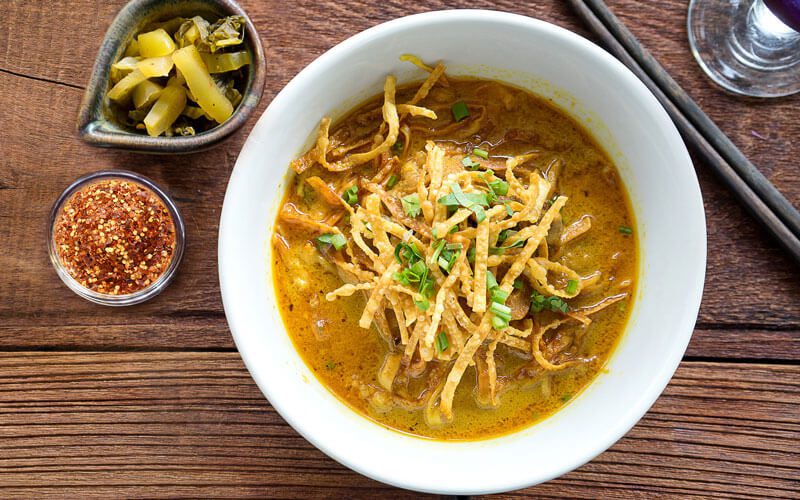
Khao Soy
Sai Oua (Sausage with Herbs)
Sai Oua is a fiery starter dish in the form of a Nordic-way sausage made with grounded pork, dried chilies, garlic, shallots, and many types of herbs and spices. It looks like a Nordic sausage on the charcoal grill but Sai Oua is meatier and rich in herbal and chili flavors.
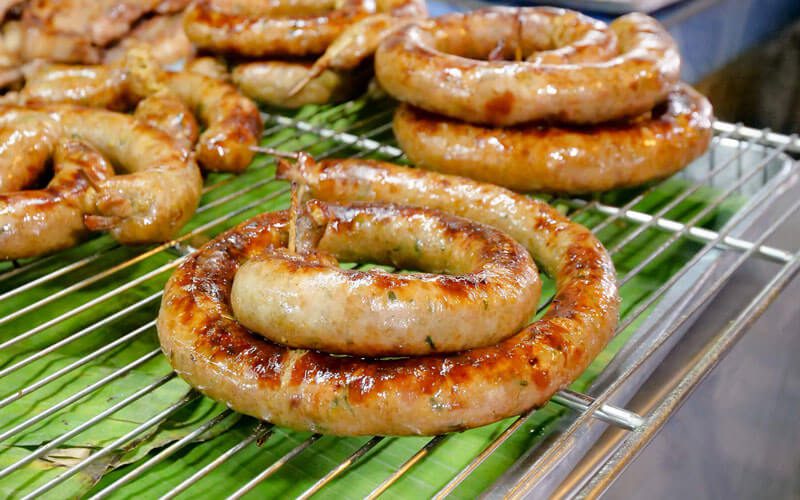
Sai-Oua
Nam Prik Ong/Nam Prik Nume
This couple of green and red chili dips are the most popular in the North. Made with roasted chili peppers, Nam Prik Nume (the green dip) is fiery and it will burn your tongue from the first bite. Red chili dip (Nam Prik Ong) has a slightly milder taste, with a tomato paste mixed with ground pork, chopped cilantro, spring onions, and dried chilies. Both are usually eaten with crispy pork skin, steamed vegetables, or sticky rice.
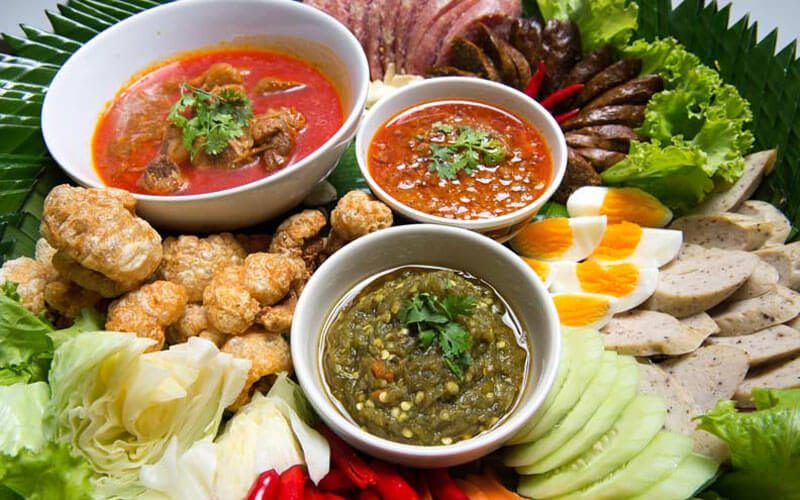
Nam Prik Ong (red) and Nam Prik Nume (green)
Tam Khanun (Young Jackfruit Salad)
Tam Khanun is a refreshing, spicy, and tasty dish. This dish will wake you up from your slumber. The young green jackfruit is boiled until tender, then shredded and mixed with dried chili, garlic, prawn paste, and a handful of herbs. Take a bite and the rich, sweet, sour, salty, and nutty taste will explode in your mouth.
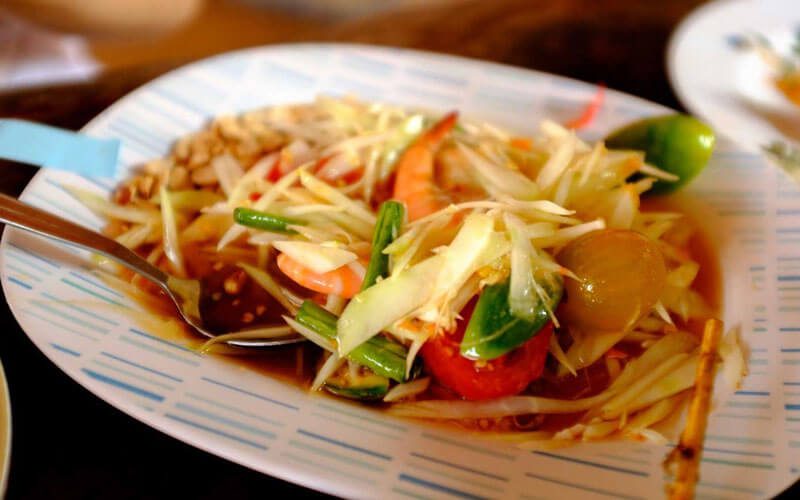
Tam Khanun
Holidays and Festivals in Chiang Mai
There are 3 main holidays and festivals that attract many Thais and tourists to Chiang Mai every year:
- The Songkran takes place every year in April to celebrate the Thai New Year. The tradition is to sprinkle everyone with water. And all the means are possible, bottles, buckets, cans, water guns. It last for a whole week.
- Loi Krathong or the “Festival of Lights” where thousands of lanterns float in the sky and on the rivers in November.
- The Chiang Mai Flower Festival takes place on the first weekend of February every year. Dance shows, parades of flowery floats, and concerts are organized to celebrate the occasion.
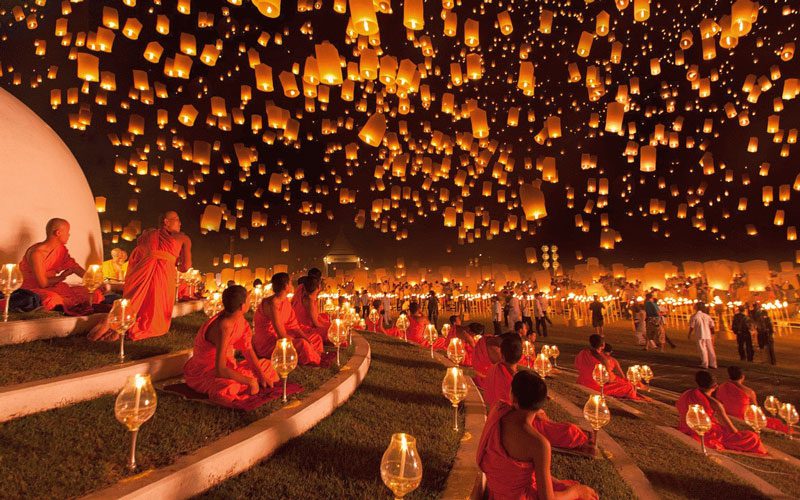
Loi Krathong festival
Would you like to visit Chiang Mai from the perspective of a local, and explore nature and untouched places? Do not hesitate to contact us for more details!
Start planning your tailor-made tour with 1-1 help from our travel advisors.
- Plan your tailor - made trip with a local expert
- Book securely with money-back guarantee
- Travel stress-free with local 24/7 support

